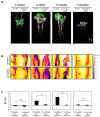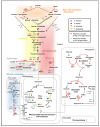Modulation of Energy Metabolism Is Important for Low-Oxygen Stress Adaptation in Brassicaceae Species
- PMID: 32150906
- PMCID: PMC7084654
- DOI: 10.3390/ijms21051787
Modulation of Energy Metabolism Is Important for Low-Oxygen Stress Adaptation in Brassicaceae Species
Abstract
Low-oxygen stress, mainly caused by soil flooding, is a serious abiotic stress affecting crop productivity worldwide. To understand the mechanisms of low-oxygen stress responses and adaptation of plants, we characterized and compared low-oxygen responses in six species with different accessions of the Brassicaceae family. Based on the growth and survival responses to submergence or low-oxygen condition, these accessions could be divided into three groups: (i) Highly tolerant species (Rorippa islandica and Arabis stelleri); (ii) moderately tolerant species (Arabidopsis thaliana [esk-1, Ler, Ws and Col-0 ecotype]); and (iii) intolerant species (Thlaspi arvense, Thellungiella salsuginea [Shandong and Yukon ecotype], and Thellungiella parvula). Gene expression profiling using Operon Arabidopsis microarray was carried out with RNA from roots of A. thaliana (Col-0), A. stelleri, R. islandica, and T. salsuginea (Shandong) treated with low-oxygen stress (0.1% O2/99.9% N2) for 0, 1, 3, 8, 24, and 72 h. We performed a comparative analysis of the gene expression profiles using the gene set enrichment analysis (GSEA) method. Our comparative analysis suggested that under low-oxygen stress each species distinctively reconfigures the energy metabolic pathways including sucrose-starch metabolism, glycolysis, fermentation and nitrogen metabolism, tricarboxylic acid flow, and fatty acid degradation via beta oxidation and glyoxylate cycle. In A. thaliana, a moderately tolerant species, the dynamical reconfiguration of energy metabolisms occurred in the early time points of low-oxygen treatment, but the energy reconfiguration in the late time points was not as dynamic as in the early time points. Highly tolerant A. stelleri appeared to have high photosynthesis capacity that could produce more O2 and in turn additional ATP energy to cope with energy depletion caused by low-oxygen stress. R. islandica seemed to retain some ATP energy produced by anaerobic energy metabolism during a prolonged period of low-oxygen conditions. Intolerant T. salsuginea did not show significant changes in the expression of genes involved in anaerobic energy metabolisms. These results indicate that plants developed different energy metabolisms to cope with the energy crisis caused by low-oxygen stress.
Keywords: Brassicaceae; energy metabolism; gene set enrichment analysis (GSEA); hypoxia; low oxygen.
Conflict of interest statement
The authors declare that the research was conducted in the absence of any commercial or financial relationships that could be construed as a potential conflict of interest.
Figures






Similar articles
-
Root transcript profiling of two Rorippa species reveals gene clusters associated with extreme submergence tolerance.Plant Physiol. 2013 Nov;163(3):1277-92. doi: 10.1104/pp.113.222588. Epub 2013 Sep 27. Plant Physiol. 2013. PMID: 24077074 Free PMC article.
-
Global transcriptome analysis provides new insights in Thellungiella salsuginea stress response.Plant Biol (Stuttg). 2019 Sep;21(5):796-804. doi: 10.1111/plb.13006. Epub 2019 Jun 6. Plant Biol (Stuttg). 2019. PMID: 31081576
-
Comparative profiling of membrane lipids during water stress in Thellungiella salsuginea and its relative Arabidopsis thaliana.Phytochemistry. 2014 Dec;108:77-86. doi: 10.1016/j.phytochem.2014.09.012. Epub 2014 Oct 9. Phytochemistry. 2014. PMID: 25308761
-
Metal hyperaccumulation and hypertolerance: a model for plant evolutionary genomics.Curr Opin Plant Biol. 2011 Jun;14(3):252-9. doi: 10.1016/j.pbi.2011.04.003. Epub 2011 Apr 29. Curr Opin Plant Biol. 2011. PMID: 21531166 Review.
-
Natural Variation in Freezing Tolerance and Cold Acclimation Response in Arabidopsis thaliana and Related Species.Adv Exp Med Biol. 2018;1081:81-98. doi: 10.1007/978-981-13-1244-1_5. Adv Exp Med Biol. 2018. PMID: 30288705 Review.
Cited by
-
Proteomic and metabolomic revealed the effect of shading treatment on cigar tobacco.Front Plant Sci. 2024 Jul 19;15:1433575. doi: 10.3389/fpls.2024.1433575. eCollection 2024. Front Plant Sci. 2024. PMID: 39100083 Free PMC article.
-
Aconitase: To Be or not to Be Inside Plant Glyoxysomes, That Is the Question.Biology (Basel). 2020 Jul 12;9(7):162. doi: 10.3390/biology9070162. Biology (Basel). 2020. PMID: 32664680 Free PMC article. Review.
-
Non-Targeted Metabolomic Analysis of Arabidopsis thaliana (L.) Heynh: Metabolic Adaptive Responses to Stress Caused by N Starvation.Metabolites. 2023 Sep 18;13(9):1021. doi: 10.3390/metabo13091021. Metabolites. 2023. PMID: 37755301 Free PMC article.
-
Application of multiomics analysis to plant flooding response.Front Plant Sci. 2024 Aug 13;15:1389379. doi: 10.3389/fpls.2024.1389379. eCollection 2024. Front Plant Sci. 2024. PMID: 39193215 Free PMC article. Review.
-
Proteomic Studies of Roots in Hypoxia-Sensitive and -Tolerant Tomato Accessions Reveal Candidate Proteins Associated with Stress Priming.Cells. 2022 Jan 31;11(3):500. doi: 10.3390/cells11030500. Cells. 2022. PMID: 35159309 Free PMC article.
References
MeSH terms
Substances
Grants and funding
- 201204010305010010500/Research Cooperating Program for Agricultural Science & Technology Development
- 2017K1A1A2013146/the National Research Foundation of Korea (NRF) funded by the Ministry of Science and ICT (MSIT)
- PJ01330101/Next-Generation BioGreen21 Program by the Rural Development Administration, Korea
LinkOut - more resources
Full Text Sources
Molecular Biology Databases

